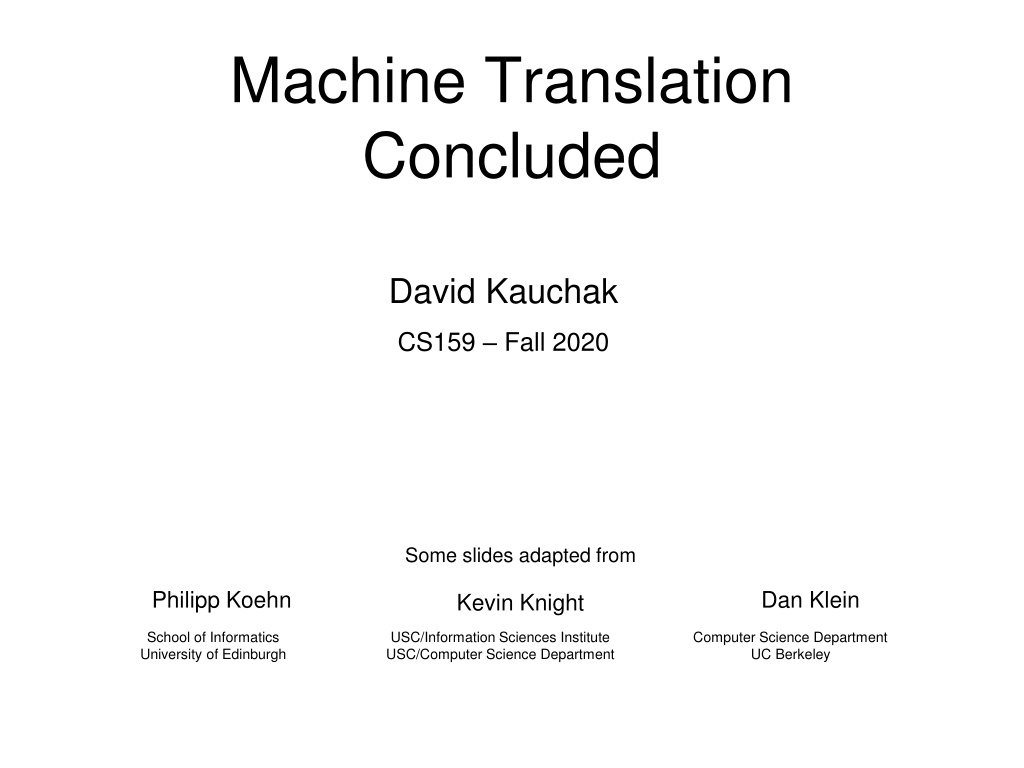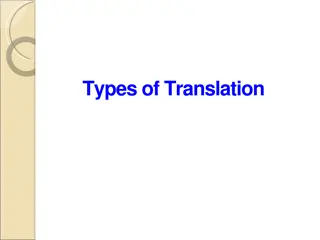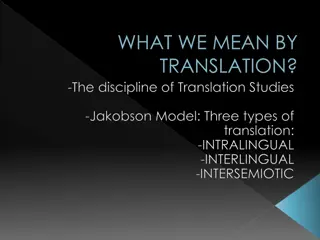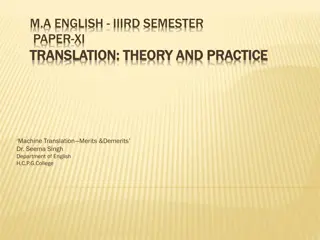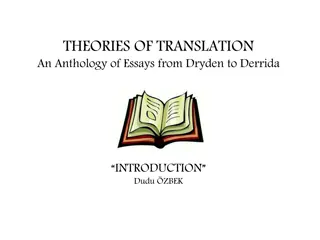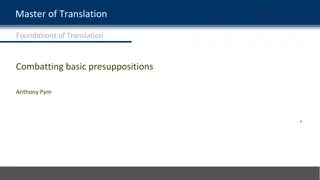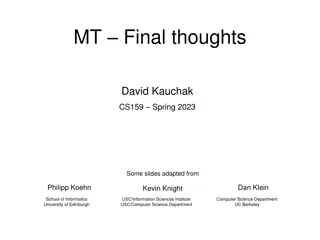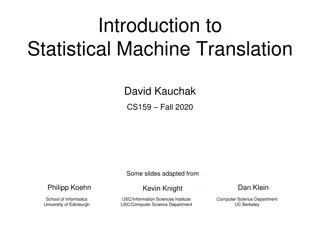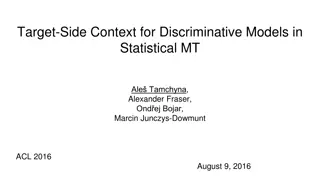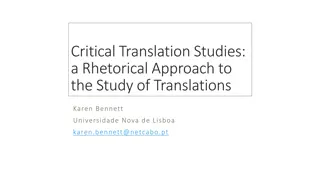Machine Translation Concluded
These slides provide a detailed explanation of various machine translation algorithms, including IBM Model 1, EM alignment, and training without alignments. Learn about the process of aligning foreign words to English words, calculating probabilities, and refining models to improve translation accuracy. Dive into the world of language translation with insightful visuals and step-by-step explanations.
Download Presentation

Please find below an Image/Link to download the presentation.
The content on the website is provided AS IS for your information and personal use only. It may not be sold, licensed, or shared on other websites without obtaining consent from the author.If you encounter any issues during the download, it is possible that the publisher has removed the file from their server.
You are allowed to download the files provided on this website for personal or commercial use, subject to the condition that they are used lawfully. All files are the property of their respective owners.
The content on the website is provided AS IS for your information and personal use only. It may not be sold, licensed, or shared on other websites without obtaining consent from the author.
E N D
Presentation Transcript
Machine Translation Concluded David Kauchak CS159 Fall 2020 Some slides adapted from Kevin Knight Philipp Koehn Dan Klein School of Informatics University of Edinburgh USC/Information Sciences Institute USC/Computer Science Department Computer Science Department UC Berkeley
Admin Assignment 5b Assignment 6 available Quiz 3: 11/10
Language translation Hola!
Word models: IBM Model 1 Mary did not slap the green witch NULL p(verde | green) Maria no di una botefada a la bruja verde Each foreign word is aligned to exactly one English word This is the ONLY thing we model! |F| p(f1f2...fF,a1a2...a|F||e1e2...eE)= p(fi|eai) i=1
Training without alignments Initially assume a p(f|e) are equally probable Repeat: Enumerate all possible alignments Calculate how probable the alignments are under the current model (i.e. p(f|e)) Recalculate p(f|e) using counts from all alignments, weighted by how probable they are (Note: theoretical algorithm)
EM alignment E-step Enumerate all possible alignments Calculate how probable the alignments are under the current model (i.e. p(f|e)) M-step Recalculate p(f|e) using counts from all alignments, weighted by how probable they are (Note: theoretical algorithm)
the house the house green house green house la casa la casa casa verde casa verde the house the house green house green house la casa la casa casa verde casa verde p( casa | green) 1/2 p( casa | house) 1/2 p( casa | the) 1/2 p( verde | green) 1/2 p( verde | house) 1/4 p( verde | the) 0 p( la | green ) 0 p( la | house ) 1/4 p( la | the ) 1/2 E-step: Given p(F|E), calculate p(A,F|E)
the house the house green house green house 1/8 1/4 1/4 1/8 la casa la casa casa verde casa verde the house the house green house green house 1/4 1/4 1/8 1/8 la casa la casa casa verde casa verde p( casa | green) 1/2 p( casa | house) 1/2 p( casa | the) 1/2 p( verde | green) 1/2 p( verde | house) 1/4 p( verde | the) 0 p( la | green ) 0 p( la | house ) 1/4 p( la | the ) 1/2 E-step: Given p(F|E), calculate p(A,F|E) Calculate unnormalized counts
the house the house green house green house 1/8 1/4 1/4 1/8 la casa la casa casa verde casa verde the house the house green house green house 1/4 1/4 1/8 1/8 la casa la casa casa verde casa verde sum = (3/4) sum = (3/4) p( casa | green) 1/2 p( casa | house) 1/2 p( casa | the) 1/2 p( verde | green) 1/2 p( verde | house) 1/4 p( verde | the) 0 p( la | green ) 0 p( la | house ) 1/4 p( la | the ) 1/2 ?(?,??|?) ?=1 ?(?,??|?) ? ???,? = 4 E-step: Given p(F|E), calculate p(A,F|E) Normalize by the sum
the house the house green house green house 1/6 1/3 1/3 1/6 la casa la casa casa verde casa verde the house the house green house green house 1/3 1/3 1/6 1/6 la casa la casa casa verde casa verde sum = (3/4) sum = (3/4) p( casa | green) 1/2 p( casa | house) 1/2 p( casa | the) 1/2 p( verde | green) 1/2 p( verde | house) 1/4 p( verde | the) 0 p( la | green ) 0 p( la | house ) 1/4 p( la | the ) 1/2 ?(?,??|?) ?=1 ?(?,??|?) ? ???,? = 4 E-step: Given p(F|E), calculate p(A,F|E) Normalize by the sum
the house the house green house green house 1/6 1/3 1/3 1/6 la casa la casa casa verde casa verde the house the house green house green house 1/3 1/3 1/6 1/6 la casa la casa casa verde casa verde M-step: calculate unnormalized counts for p(f|e) given the alignments p( casa | green) p( casa | house) p( casa | the) p( verde | green) p( verde | house) p( verde | the) p( la | green ) ( la | house ) p( la | the ) c(casa,the) = 1/6+1/3 = 3/6 c(verde,the) = 0 c(la,the) = 1/3+1/3 = 4/6 c(casa,green) = 1/6+1/3 = 3/6 c(verde,green) = 1/3+1/3 = 4/6 c(la, green) = 0 c(casa,house) = 1/3+1/6+ 1/3+1/6 = 6/6 c(verde,house) = 1/6+1/6 = 2/6 c(la,house) = 1/6+1/6 = 2/6
the house the house green house green house 1/6 1/3 1/3 1/6 la casa la casa casa verde casa verde the house the house green house green house 1/3 1/3 1/6 1/6 la casa la casa casa verde casa verde M-step: normalize p( casa | green) 3/7 p( casa | house) 3/5 p( casa | the) 3/7 p( verde | green) 4/7 p( verde | house) 1/5 p( verde | the) 0 p( la | green ) 0 p( la | house ) 1/5 p( la | the ) 4/7 c(casa,the) = 1/6+1/3 = 3/6 c(verde,the) = 0 c(la,the) = 1/3+1/3 = 4/6 c(casa,green) = 1/6+1/3 = 3/6 c(verde,green) = 1/3+1/3 = 4/6 c(la, green) = 0 c(casa,house) = 1/3+1/6+ 1/3+1/6 = 6/6 c(verde,house) = 1/6+1/6 = 2/6 c(la,house) = 1/6+1/6 = 2/6 Then, calculate the probabilities by normalizing the counts
Implementation details For |E| English words and |F| foreign words, how many alignments are there? Repeat: E-step Enumerate all possible alignments Calculate how probable the alignments are under the current model (i.e. p(f|e)) M-step Recalculate p(f|e) using counts from all alignments, weighted by how probable they are
Implementation details Each foreign word can be aligned to any of the English words (or NULL) (|E|+1)|F| Repeat: E-step Enumerate all possible alignments Calculate how probable the alignments are under the current model (i.e. p(f|e)) M-step Recalculate p(f|e) using counts from all alignments, weighted by how probable they are
Thought experiment The old man is happy. He has fished many times. El viejo est feliz porque ha pescado muchos veces. The sharks await. His wife talks to him. Los tiburones esperan. Su mujer habla con l. p(fi|eai)=count(faligned-toe) p(el | the) = 0.5 p(Los | the) = 0.5 count(e)
If we had the alignments Input: corpus of English/Foreign sentence pairs along with alignment for (E, F) in corpus: for aligned words (e, f) in pair (E,F): count(e,f) += 1 count(e) += 1 for all (e,f) in count: p(f|e) = count(e,f) / count(e)
If we had the alignments Input: corpus of English/Foreign sentence pairs along with alignment for (E, F) in corpus: for e in E: for f in F: if f aligned-to e: count(e,f) += 1 count(e) += 1 for all (e,f) in count: p(f|e) = count(e,f) / count(e)
If we had the alignments Input: corpus of English/Foreign sentence pairs along with alignment for (E, F) in corpus: for aligned words (e, f) in pair (E,F): count(e,f) += 1 count(e) += 1 for (E, F) in corpus for e in E: for f in F: if f aligned-to e: count(e,f) += 1 count(e) += 1 Are these equivalent? for all (e,f) in count: p(f|e) = count(e,f) / count(e)
Thought experiment #2 The old man is happy. He has fished many times. 80 annotators El viejo est feliz porque ha pescado muchos veces. The old man is happy. He has fished many times. 20 annotators El viejo est feliz porque ha pescado muchos veces. Use partial counts: - count(viejo | man) 0.8 - count(viejo | old) 0.2 p(fi|eai)=count(faligned-toe) count(e)
Without the alignments if f aligned-to e: count(e,f) += 1 count(e) += 1 ? ? e : probability that f is aligned to e in this pair count(e,f) += ? ? e count(e) += ? ? e Key: use expected counts (i.e., how likely based on the current model), rather than actual counts
Without alignments ? ? e : probability that f is aligned to e in this pair a b c y z What is ? ? a ? Put another way, of all things that y could align to in this sentence, how likely is it to be a?
Without alignments ? ? e : probability that f is aligned to e in this pair a b c y z Of all things that y could align to, how likely is it to be a: p(y | a) Does that do it? No! p(y | a) is how likely y is to align to a over the whole data set.
Without alignments ? ? e : probability that f is aligned to e in this pair a b c y z Of all things that y could align to, how likely is it to be a: p(y | a) p(y | a) + p(y | b) + p(y | c)
Without the alignments Input: corpus of English/Foreign sentence pairs along with alignment for (E, F) in corpus: for e in E: for f in F: ? ? e = p f e)/ ? ?? ??(?|?) count(e,f) += ? ? e count(e) += ? ? e for all (e,f) in count: p(f|e) = count(e,f) / count(e)
EM: without the alignments Input: corpus of English/Foreign sentence pairs along with alignment for some number of iterations: for (E, F) in corpus: for e in E: for f in F: ? ? e = p f e)/ ? ?? ??(?|?) count(e,f) += ? ? e count(e) += ? ? e for all (e,f) in count: p(f|e) = count(e,f) / count(e)
EM: without the alignments Input: corpus of English/Foreign sentence pairs along with alignment for some number of iterations: for (E, F) in corpus: for e in E: for f in F: ? ? e = p f e)/ ? ?? ??(?|?) count(e,f) += ? ? e count(e) += ? ? e for all (e,f) in count: p(f|e) = count(e,f) / count(e)
EM: without the alignments Input: corpus of English/Foreign sentence pairs along with alignment for some number of iterations: for (E, F) in corpus: for e in E: for f in F: ? ? e = p f e)/ ? ?? ??(?|?) count(e,f) += ? ? e count(e) += ? ? e for all (e,f) in count: p(f|e) = count(e,f) / count(e) Where are the E and M steps?
EM: without the alignments Input: corpus of English/Foreign sentence pairs along with alignment for some number of iterations: for (E, F) in corpus: for e in E: for f in F: ? ? e = p f e)/ ? ?? ??(?|?) count(e,f) += ? ? e count(e) += ? ? e for all (e,f) in count: p(f|e) = count(e,f) / count(e) Calculate how probable the alignments are under the current model (i.e. p(f|e))
EM: without the alignments Input: corpus of English/Foreign sentence pairs along with alignment for some number of iterations: for (E, F) in corpus: for e in E: for f in F: ? ? e = p f e)/ ? ?? ??(?|?) count(e,f) += ? ? e count(e) += ? ? e for all (e,f) in count: p(f|e) = count(e,f) / count(e) Recalculate p(f|e) using counts from all alignments, weighted by how probable they are
NULL Sometimes foreign words don t have a direct correspondence to an English word Adding a NULL word allows for p(f | NULL), i.e. words that appear, but are not associated explicitly with an English word Implementation: add NULL (or some unique string representing NULL) to each of the English sentences, often at the beginning of the sentence p( casa | NULL) 1/3 p( verde | NULL) 1/3 p( la | NULL ) 1/3
Benefits of word-level model Rarely used in practice for modern MT system Mary did not slap the green witch e1 e2 e3 e4 e0 e5 e6 e7 f3 f5 f6f7 f8 f9 f1 f2 f4 Maria no di una botefada a la bruja verde Two key side effects of training a word-level model: Word-level alignment p(f | e): translation dictionary How do I get this?
Word alignment 100 iterations green house p( casa | green) 0.005 casa verde p( verde | green) 0.995 p( la | green ) 0 How should these be aligned? p( casa | house) ~1.0 p( verde | house) ~0.0 the house p( la | house ) ~0.0 la casa p( casa | the) 0.005 p( verde | the) 0 p( la | the ) 0.995
Word alignment 100 iterations green house p( casa | green) 0.005 casa verde p( verde | green) 0.995 p( la | green ) 0 Why? p( casa | house) ~1.0 p( verde | house) ~0.0 the house p( la | house ) ~0.0 la casa p( casa | the) 0.005 p( verde | the) 0 p( la | the ) 0.995
Word-level alignment alignment(E,F)=argAmaxp(A,F|E) Which for IBM model 1 is: |F| alignment(E,F)=argAmax p(fi|eai) i=1 Given a model (i.e. trained p(f|e)), how do we find this? Align each foreign word (f in F) to the English word (e in E) with highest p(f|e) ai=argj:1-|E|maxp(fi|ej)
Word-alignment Evaluation The old man is happy. He has fished many times. El viejo est feliz porque ha pescado muchos veces. How good of an alignment is this? How can we quantify this?
Word-alignment Evaluation System: The old man is happy. He has fished many times. El viejo est feliz porque ha pescado muchos veces. Human The old man is happy. He has fished many times. El viejo est feliz porque ha pescado muchos veces. How can we quantify this?
Word-alignment Evaluation System: The old man is happy. He has fished many times. El viejo est feliz porque ha pescado muchos veces. Human The old man is happy. He has fished many times. El viejo est feliz porque ha pescado muchos veces. Precision and recall!
Word-alignment Evaluation System: The old man is happy. He has fished many times. El viejo est feliz porque ha pescado muchos veces. Human The old man is happy. He has fished many times. El viejo est feliz porque ha pescado muchos veces. 6 7 6 10 Precision: Recall:
Problems for Statistical MT Preprocessing Language modeling Translation modeling Decoding Parameter optimization Evaluation
What kind of Translation Model? Mary did not slap the green witch Word-level models Phrasal models Syntactic models Semantic models Maria no di una botefada a la bruja verde
Phrasal translation model The models define probabilities over inputs p(f |e) Morgen fliege ich nach Kanada zur Konferenz 1. Sentence is divided into phrases
Phrasal translation model The models define probabilities over inputs p(f |e) Morgen fliege ich nach Kanada zur Konferenz Tomorrow will fly I In Canada to the conference 1. Sentence is divided into phrases 2. Phrases are translated (avoids a lot of weirdness from word-level model)
Phrasal translation model The models define probabilities over inputs p(f |e) Morgen fliege ich nach Kanada zur Konferenz Tomorrow I will fly to the conference In Canada 1. Sentence is divided into phrases 2. Phrase are translated (avoids a lot of weirdness from word-level model) 3. Phrases are reordered
Phrase table natuerlich Translation Probability of course 0.5 naturally 0.3 of course , 0.15 , of course , 0.05
Phrase table den Vorschlag Translation Probability the proposal 0.6227 s proposal 0.1068 a proposal 0.0341 the idea 0.0250 this proposal 0.0227 proposal 0.0205 of the proposal 0.0159 the proposals 0.0159 the suggestions 0.0114
Phrasal translation model The models define probabilities over inputs p(f |e) Morgen fliege ich nach Kanada zur Konferenz Tomorrow I will fly to the conference In Canada Advantages?
Advantages of Phrase-Based Many-to-many mappings can handle non- compositional phrases Easy to understand Local context is very useful for disambiguating Interest rate Interest in The more data, the longer the learned phrases Sometimes whole sentences!
Syntax-based models S Benefits? VP NP VP PP NP NP NP NP NP NNS VBG NNP CC NNP PUNC DT CD VBP NNS IN . These 7 people include astronauts coming from France and Russia
Syntax-based models Benefits Can use syntax to motivate word/phrase movement Could ensure grammaticality Two main types: p(foreign string | English parse tree) p(foreign parse tree | English parse tree)
Tree to string rule S , x0:NP x1:VP ADVP -> x0:NP * x1:VP , RB therefore
